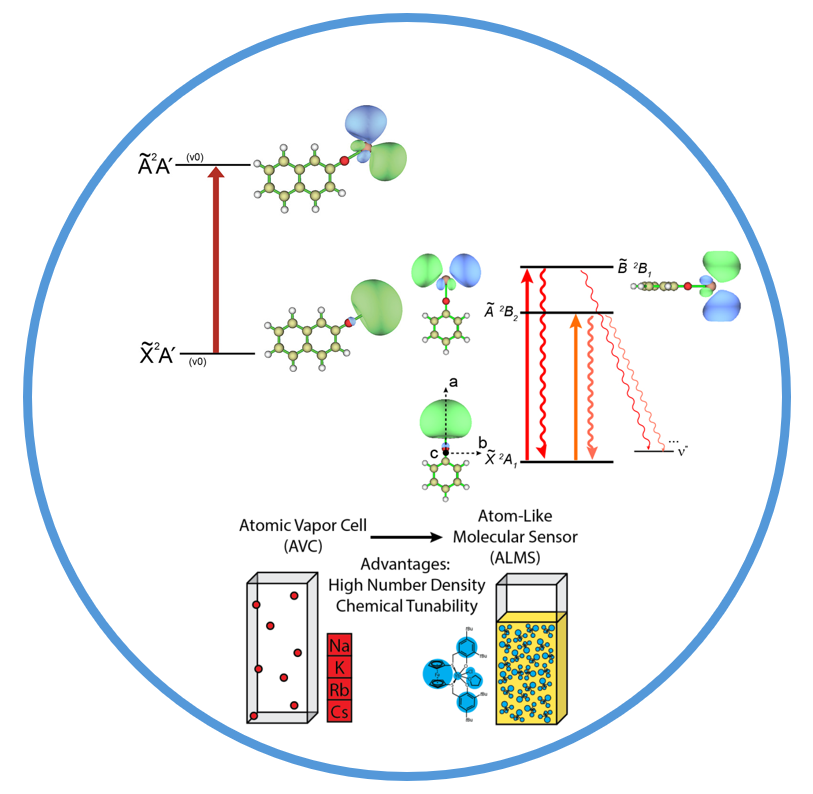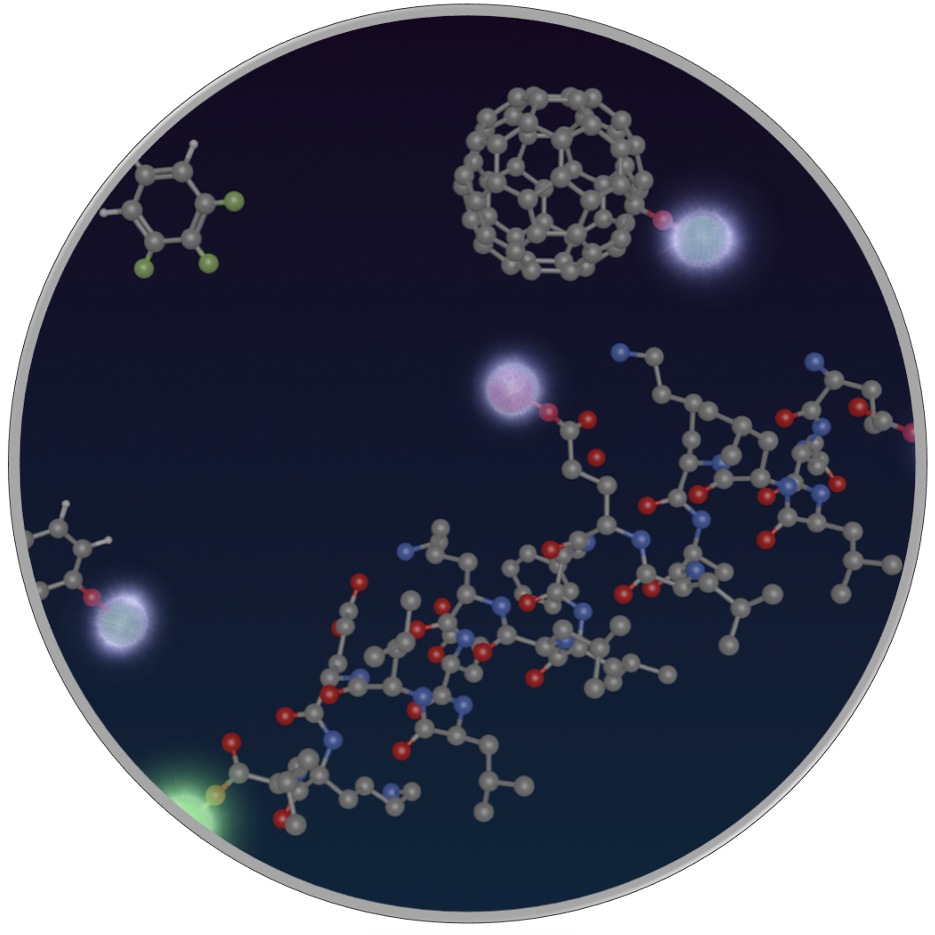

Our Team
This project requires computation for predictions of new molecular species hosting quantum functionalities (PI, Anastassia Alexandrova, UCLA), new theoretical methods to enable some of the predictions (Anna Krylov, USC), synthesis to make the predicted molecules (Miguel Garcia-Garibay, UCLA), spectroscopy to test them (Justin Caram, UCLA), and QIS experts to tailor to desired applications and provide authentic assessment of resulting functionality (Eric Hudson, UCLA).


Research
Achieving quantum enhancement in sensing, communication, and computing requires the high-fidelity preparation, maintenance, and readout of defined quantum states, which then would be resistant to decoherence and amenable to entanglement. So far, the most successful systems that exhibit such clean quantum states are those of extreme simplicity: atoms, very small molecules in vacuo, and defects in solids. Because the electronic states in these systems are “closed”, i.e. strictly localized to an atom or a defect, they can be optically cycled without dissipation to the environment, and decoherence can be managed. However, what is gained in coherence, is lost in system complexity and thus flexibility, scalability and eventual practicability. This chemistry Center will use the rules of chemistry to substantially expand the repertoire of systems, and therefore the capabilities, available for QIS. We will design molecules that carry qubit functionalities (or quantum functional groups), by using chemical complexity rather than avoiding it. Since molecules are identical and can be synthesized in molar quantities, they can be assembled into scalable, next generation quantum information platforms – a combination of features not yet realized. In this way, the Center will enable the quantum leap, and open a new branch of chemistry: chemistry of QIS.


Broader Impacts
The Center will educate researchers at the intersection of traditional disciplines, where the future of QIS resides. It will recruit students at all levels and from diverse backgrounds, using innovative recruiting strategies, and with defined metrics of success. Promoting women and underrepresented groups will be central to all our activities. The Center will make a significant effort toward community building through organizing symposia, bootcamps, workshops, cross-departmental courses, innovative modules for undergraduate classes, and regular communication of all researchers of the Center, from all involved backgrounds. Outreach to the public will be done using established and successful platforms, as a prototype for expansion in Phase II.


Publications
- Vibronic Engineering for Quantum Functional Groups by Haowen Zhou, Taras Khvorost, Anastassia N. Alexandrova*, Justin R. Caram*
- Photoswitching molecules functionalized with optical cycling centers provide a novel platform for studying chemical transformations in ultracold molecules by Paweł Wójcik, Taras Khvorost, Guanming Lao, Guozhu Zhu, Antonio Macias Jr, Justin Caram, Wesley Campbell, Miguel García-Garibay, Eric Hudson, Anastassia Alexandrova, and Anna Krylov
- Bottom-up approach to scalable growth of molecules capable of optical cycling by Guanming Lao, Taras Khvorost, Antonio Macias Jr., Harry W. T. Morgan, Robert H. Lavroff, Ryan Choi, Haowen Zhou, Denis Usvyat, Guo-Zhu Zhu, Miguel A. García-Garibay, Anastassia N. Alexandrova, Eric R. Hudson, and Wesley C. Campbell
- Dual Optical Cycling Centers Mounted on an Organic Scaffold: New Insights from Quantum Chemistry Calculations and Symmetry Analysis by Taras Khvorost, Paweł Wójcik, Cecilia Chang, Mia Calvillo, Claire Dickerson, Guanming Lao, Eric R. Hudson, Anna I. Krylov, and Anastassia N. Alexandrov
- State-interaction approach for evaluating g-tensors within EOM-CC and RAS-CI frameworks: Theory and benchmarks by Sven Kähler, Antonio Cebreiro-Gallardo, Pavel Pokhilko, David Casanova, and Anna I Krylov
- Origin of magnetic anisotropy in nickelocene molecular magnet and resilience of its magnetic behavior by Maristella Alessio, Saikiran Kotaru, Goran Giudetti, Anna I. Krylov
- Spin-orbit couplings within spin-conserving and spin-flipping time-dependent density functional theory: Implementation and benchmark calculation by Saikiran Kotaru, Pavel Pokhilko, and Anna I. Krylov
- Aperiodic fragments in periodic solids: Eliminating the need for supercells and background charges in electronic structure calculations of defects by Robert H. Lavroff, Daniel Kats, Lorenzo Maschio, Nikolay Bogdanov, Ali Alavi, Anastassia N. Alexandrova, and Denis Usvyat
- A Simple Algorithm for Converting Random Number Generator Outputs to Universal Distributions to Aid Teaching and Research in Modern Physical Chemistry by Barry Y. Li, Tim Duong, Daniel Neuhauser, Anastassia N. Alexandrova, and Justin R. Caram
- Toward liquid cell quantum sensing: Ytterbium complexes with ultranarrow absorption by Ashley J. Shin, Changling Zhao, Yi Shen, Claire E. Dickerson, Barry Y. Li, Hootan Roshandel, Daniel Bím, Timothy L. Atallah, Paul H. Oyala, Yongjia He, Lianne K. Alson, Tyler A. Kerr, Anastassia N. Alexandrova, Paula L. Diaconescu, Wesley C. Campbell, and Justin R. Caram
- Elucidating Ultranarrow 2F7/2 to 2F5/2 Absorption in Ytterbium(III) Complexes by Barry Y. Li, Claire E. Dickerson, Ashley J. Shin, Changling Zhao, Yi Shen, Yongjia He, Paula L. Diaconescu, Anastassia N. Alexandrova, and Justin R. Caram
- Single molecule superradiance for optical cycling by Claire E. Dickerson, Anastassia N. Alexandrova, Prineha Narang, and John P. Philbin
- Probing the limits of optical cycling in a predissociative diatomic molecule by Qi Sun, Claire E. Dickerson, Jinyu Dai, Isaac M. Pope, Lan Cheng, Daniel Neuhauser, Anastassia N. Alexandrova, Debayan Mitra, and Tanya Zelevinsky
- Physical Chemistry of Quantum Information Science by Tanya Zelevinsky, Artur F. Izmaylov, and Anastassia N. Alexandrova
- Extending the Large Molecule Limit: The Role of Fermi Resonance in Developing a Quantum Functional Group by Guo-Zhu Zhu, Guanming Lao, Claire E. Dickerson, Justin R. Caram, Wesley C. Campbell, Anastassia N. Alexandrova, and Eric R. Hudson
- Fully Saturated Hydrocarbons as Hosts of Optical Cycling Centers by Claire E. Dickerson, Cecilia Chang, Han Guo, and Anastassia N. Alexandrova
- Laser spectroscopy of aromatic molecules with optical cycling centers: strontium (I) phenoxides by Guanming Lao, Guo-Zhu Zhu, Claire E. Dickerson, Benjamin L. Augenbraun, Anastassia N. Alexandrova, Justin R. Caram, Eric R. Hudson, and Wesley C. Campbell
- Pathway toward Optical Cycling and Laser Cooling of Functionalized Arenes by Debayan Mitra, Zack D. Lasner, Guo-Zhu Zhu, Claire E. Dickerson, Benjamin L. Augenbraun, Austin D. Bailey, Anastassia N. Alexandrova, Wesley C. Campbell, Justin R. Caram, Eric R. Hudson, and John M. Doyle
- On the prospects of optical cycling in diatomic cations: effects of transition metals, spin–orbit couplings, and multiple bonds by Paweł Wójcika, Eric R. Hudson, and Anna I. Krylov


News and Updates
January 10, 2024 | Ph.D. student creates video for UCLA College’s “Silly Questions, Smart Bruins” series
September 13, 2022 | Womanium Quantum Computing and Entrepreneurship Program
August 23, 2022 | NSF-funded UCLA center to develop chemical qubits for quantum computing
August 02, 2022 | UCLA-led team develops new approach for building quantum computers
